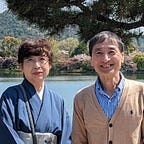An Intimate Exploration into Kyoto: Serene Solitudes & Timeless Tales
— Article 2: Tofukuji and Its 25 Subsidiary Temples —
In early December 2020, I embarked on a quest to secure a residence in Kyoto, anticipating my move the following March. During this journey, I took the opportunity to visit Tofukuji Temple. Founded in the 13th century, Tofukuji is renowned for its autumnal beauty.
Before the pandemic, Tofukuji would be teeming with visitors during the fall, each vying for a glimpse of the ancient architecture colored with autumn leaves. Yet, on this visit, an unexpected serenity greeted me. I was afforded the luxury of spending several minutes at each vantage point — starkly contrasting the usual hurried seconds dictated by long queues.
Tofukuji is not just famed for its seasonal foliage but also its six distinct gardens, each radiating its unique allure and its imposing, solemn gate. The ideal periods to immerse oneself in the beauty of Tofukuji are from late March to mid-April and from mid to late November. I look forward to delving deeper into Tofukuji in future writings.
Tofukuji encompasses a primary area of approximately 250m x 300m. Surrounding it are 25 subsidiary temples, creating an expansive ancient zone measuring roughly 500m x 500m, as depicted in the accompanying photographs.
One notable subsidiary temple is Taikoan, founded in 1346. It has ties to several illustrious figures in Japanese history. Komachi Ono, a revered poet from the 9th century, stands out among them. Widely recognized as one of Japan’s most distinguished poets, she is also one of its most cherished historical figures. Intriguingly, love letters addressed to Komachi, penned by numerous aristocrats, have been secreted within a statue of Jizo (a Buddhist deity) housed in this temple for almost 700 years.
Mitsunari Ishida is another prominent figure linked to Taikoan. In the 16th century, he and his allies plotted against Ieyasu Tokugawa. However, their efforts were in vain, as Tokugawa emerged victorious, establishing the Edo shogunate. Fast forward to the 19th century, and the Choshu domain was pivotal in overthrowing this shogunate during the Meiji Restoration.
For those who haven’t seen, I encourage you to start with my previous exploration: An Intimate Exploration into Kyoto: Serene Solitudes & Timeless Tales — Article 1: Lesser Known Gems — .
Stay tuned for my forthcoming piece dedicated to the wonders of the “Kamigamo Shrine.”
